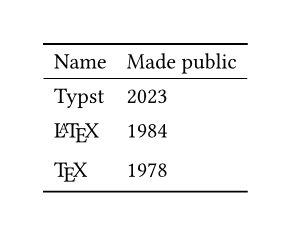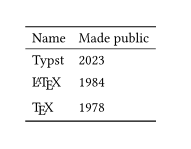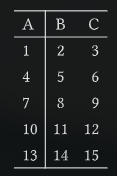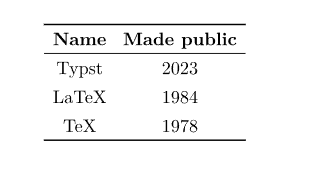In Latex, a three-line table can be created by \toprule, \midrule and \bottomrule. Is there any similar solution in Typst?
Sure. If you look at the documentation of the booktab package for LaTeX, you will find these two lengths:
\heavyrulewidth=.08em
\lightrulewidth=.05em
So we can use them to mimic the booktab look, like this:
#import "@preview/metalogo:1.0.2": TeX, LaTeX
#set table(stroke: none)
#let toprule = table.hline(stroke: 0.08em)
#let bottomrule = toprule
#let midrule = table.hline(stroke: 0.05em)
#table(
columns: 2,
toprule,
table.header(
[Name],
[Made public]
),
midrule,
[Typst], [2023],
LaTeX, [1984],
TeX, [1978],
bottomrule
)

Thank you very much!
Thanks a lot for your answer. How can I make a “three-line table” template or somethings, while there are a lot of tables in a document, and it’s kind of tiring to write “toprule”/“midrule”/“bottomrule” in every table instance.
You can create a function that does this for you. This example takes a list of values as its only argument:
#import "@preview/metalogo:1.0.2": TeX, LaTeX
#let three-line-table(cells) = {
let toprule = table.hline(stroke: 0.08em)
let bottomrule = toprule
let midrule = table.hline(stroke: 0.05em)
table(
columns: 2,
stroke: none,
toprule,
table.header(..cells.slice(0, count: 2)),
midrule,
..cells.slice(2),
bottomrule
)
}
#three-line-table(
(
[Name], [Made public],
[Typst], [2023],
LaTeX, [1984],
TeX, [1978],
)
)
Result

Nice, but the solution you proposed is hard-coded to columns: 2. Here is a more general solution using arguments; it uses the same arguments as a normal table, but adds another named one called header, which is an array of cells (I don’t know how to extract table.header from the arguments, so I put its content aside as an additional argument).
#import "@preview/metalogo:1.0.2": TeX, LaTeX
#set page(
width: auto,
height: auto,
margin: 3em,
)
#set table(stroke: none)
#let toprule = table.hline(stroke: 0.08em)
#let bottomrule = toprule
#let midrule = table.hline(stroke: 0.05em)
#let booktab(..args) = {
let named = args.named()
let header = named.remove("header")
table(
..named,
toprule,
..header,
midrule,
..args.pos(),
bottomrule
)
}
#booktab(
columns: 2,
header: (
[Name],
[Made public],
),
[Typst], [2023],
LaTeX, [1984],
TeX, [1978],
)
The rubber-article – Typst Universe has a nice and easy way to do it, using ctable:
This function will display a custom table. The table uses the
pillarpackage under the hood to interact with the table in a similar manner as in Latex. This means, that the columns and vertical lines can be defined with a string. Furthermore, the table automatically adds 3 horizontal lines.
#import "@preview/rubber-article:0.4.0": ctable
#ctable(
cols:"l|cr",
[A], [B], [C],
..range(1,16).map(str),
)

Actually, a more applicable method is to define a style:
#let three-line-table = it => {
if it.children.any(c => c.func() == table.hline) {
return it
}
let toprule = table.hline(stroke: 0.08em)
let bottomrule = toprule
let midrule = table.hline(stroke: 0.05em)
let meta = it.fields()
meta.stroke = none
meta.remove("children")
let header = it.children.find(c => c.func() == table.header)
let cells = it.children.filter(c => c.func() == table.cell)
if header == none {
let columns = meta.columns.len()
header = table.header(..cells.slice(0, columns))
cells = cells.slice(columns)
}
return table(
..meta,
toprule,
header,
midrule,
..cells,
bottomrule,
)
}
And you can use it as:
#show table: three-line-table
#table(
columns: 2,
align: center,
table.header([*Name*], [*Made public*]),
[Typst], [2023],
[LaTeX], [1984],
[TeX], [1978]
)
In that way, you don’t need to define additional functions and can use all parameters of table.
Looks like the booktabs – Typst Universe package got created! I’m a big fan of this style of typeset tables, and I’m glad a port has made its way over. Presumably it would help if you want a more ready-made solution i.e. that has done the porting for you.
